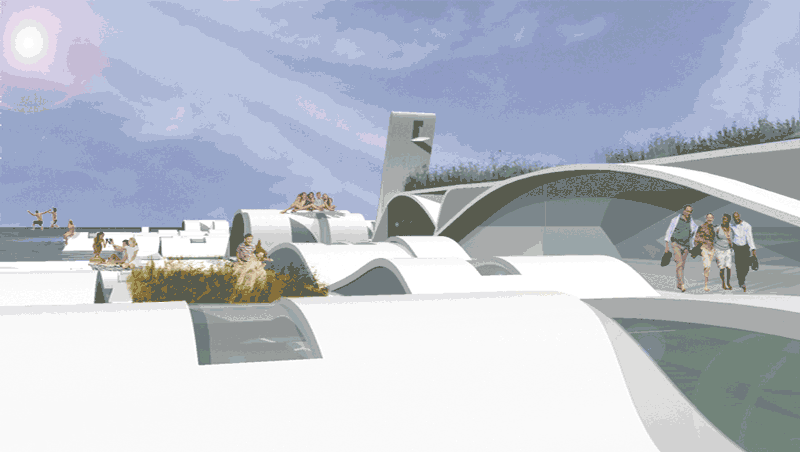
Coralie Huon Dunes Océanes 2006 video [still]
Several entries back I wrote something about noticing a "theme of homes and homelessness" during a visit to Yukiko Kawase at DIVA. The idea of home in the broader sense seemed then to be everywhere, but looking back now, I realize I was probably thinking mostly about the installations in the gallery's hotel suite bedroom space.
The French artist Coralie Huon showed a video of computer-generated images describing a utopian project for an elegant futuristic self-sustained floating community. I'm an architecture nut, especially when it comes to homes of any kind, but I wasn't very interested in this part of the room. It probably had nothing to do with it, but for someone who was entertained as a child by the fantasy covers of Popular Mechanics it all felt a bit retro (although thinking about it now, that may have been intentional). Huon probably survives day to day with her work as an interior architect, but even in her professional practice her imagination seems to be a bit more conceptual than is customary for the trade; does anyone expect her floating commune to be built?

Coralie Huon Camping Urbain 2005 mixed media
"Camping Urbain", her second installation at DIVA shares a concern for satisfying social needs responsibly and with a fundamental concept of utility but here her design skills were only her tools; the work ends up on an entirely different plane, the product of a more purely artistic imagination.
The more obvious distinction is that here she chose to address the requirements of a very different, and already existing, "lifestyle" than that which would be sheltered by her maritime utopia. As potential design clients, the homeless of Paris and other cities of the world are considerably less hypothetical than the future-sleek residents of her "Dunes Océanes". I don't expect to be in the market for either kind of home in the foreseeable future, but it was the tiny, minimal house kit installation, and the unsettling message of the tape boundaries secured on the carpet, all of which were contained within the walls of a bedroom of this warm, dry and seriously-bourgeois hotel suite that really captured my imagination [unfortunately it was too far dark and crowded to capture an image with my camera].
The visitor can read about this innovative extreme mobility house in a press release whose tongue-in-cheek style is not unlike the mock language of marketing also used to "sell" her companion project for a floating community:
It is ingenious, stylish and compact. It can be taken away anywhere thanks to its carry-on bag matching. In a short moment of minutes, it unfolds and folds back again. It is mobile, but at the same time, it is [an approximately 20 sf] pod for the homeless, my house, and my own place.In her 3 minutes video, she explains on up-beat rock music:
1. Definition of target: For whom?
2. Specifications and operations: How does it work?
3. Message: How does this communicate?
4. Demonstration: How one can live with it?Design for the homeless? This apparently non-sense idea would be a starter of discussions on the homeless issue. Here, the design can be recognized as a powerful tool. A tool to make this social issue visible, a tool to identify the homeless as a human being with dignity.
It is a multi-dimensional project complete with sound, visual, and a three-dimensional prototype. Audience will be participating and experiencing life condition of the homeless. Make them aware of the uncertainty of the existence.
Camping Urbain, playful and disturbing: not so fun, but not to be dramatized either.
Ms. Kawase, the gallery owner, told us that the artist had been surprised (amused, dismayed?) to find that visitors to the gallery's exhibition in New York showed little interest in "Camping Urbain" but were much taken by "Dunes Océanes". This was reportedly the opposite of her experience in Paris, where people are apparently truly disturbed by the increasing visibility of the homeless on the streets.
And why am I so interested in this anecdote? I doubt it's because I believe that Parisians are fundamentally more compassionate (empathetic?) than New Yorkers, and I don't think I want to believe they are. Or, if I do want to believe we're lacking something here, is it because I want to do something to help in a city where I think I could, or because I want to complain in a city where I think I have a right to complain?
Repeating the question of construction probability, does anyone expect her pods will be built, or will we come up with a better, more practical, an achieveable "utopian" solution for bringing the homeless home?
[images from Yukiko Kawase]